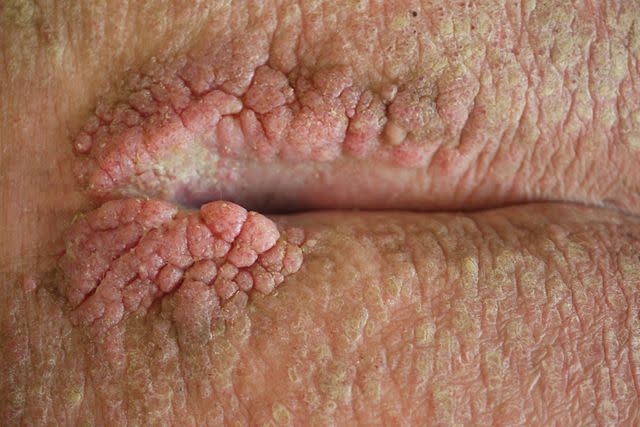Papilloma Skin Growths: What to Know
Medically reviewed by Katlein Franca, MD
A papilloma is a noncancerous tumor that grows in specific tissues on the body, known as the epithelia. These tissues are found in many areas of the body, so the growths can occur almost anywhere as well, including the lips, hands, neck, armpits, and under the chest area. When they appear on the skin, they are often called warts.
These growths are typically harmless and require no treatment. However, if they grow inward, they can cause pain that requires removal. They could also be a source of cosmetic distress for some individuals.
This article discusses the types, causes, and treatment options for papillomas.

Fly View Productions / Getty Images
Papilloma Types and Location
The location of papillomas will depend on the type. Skin papillomas occur on the outside of the body in almost all areas as long as there is epithelial tissue.
Other types include:
Intraductal: Occurs when the papilloma develops within a milk duct in the breast
Genital: Occurs when the papilloma develops in the genital area, including the penis, vulva, urethra, vagina, cervix, and around the anal area
Respiratory: When the tumor-like growths develop on the surface of the voice box, vocal cords, or surrounding tissues
Oral: An oral papilloma develops anywhere within the mouth, throat, or lips
Sinuses: This occurs when the papilloma develops within the nose or sinuses
Papillomas vs. Montgomery Tubercles
Montgomery tubercles can be often confused with intraductal papillomas, but they are not the same. While intraductal papillomas occur in the milk ducts, Montgomery tubercles are the tiny oil glands located on the areolas. They can get clogged, and in some cases, that will lead to them looking similar to papillomas.
Related: Signs and Symptoms of Human Papillomavirus (HPV) Infection

Reproduced with permission from © DermNet and © Te Whatu Ora dermnetnz.org 2023.
Papilloma and STI Link
The underlying cause of papillomas is the human papillomavirus (HPV). There are more than 200 HPV-related viruses, some of which are considered high risk while others are considered low risk. The development of papillomas is often attributed to low-risk types of HPV.
HPV is considered a sexually transmitted infection (STI) because it is primarily spread through unprotected sexual contact. That is why the development of papillomas is often linked to an STI infection. That said, HPV can also be spread through non-sexual contact as well, including:
Fomites, which are materials that can carry infection and can include furniture, clothes, and utensils
Nonsexual skin contact
Nonsexual mouth contact with an object that carries the infection
There are also certain risk factors associated with developing papillomas, including:
Having unprotected sex with people who have an HPV infection
Being born to a mother with an HPV infection
Smoking
Papilloma and Cancer Link
HPV can directly cause several types of cancer to develop, including:
Cervical cancer
Anal cancer
Oropharyngeal cancer
Penile cancer
Vaginal cancer
Vulvar cancer
There are 12 types of high-risk HPV infections, all of which can cause the cancers mentioned above. According to the National Cancer Institute, HPV infections cause the majority of these cancers:
90% of anal cancers
70% of throat cancers
63% of penile cancers
75% of vaginal cancers
69% of vulvar cancers
Cervical Cancer and HPV
Cervical cancer is the most notable type associated with HPV infections. Roughly 99.7% of all cervical cancers are caused by high-risk HPV.
Learn More: Human Papillomavirus (HPV) Facts and Statistics: What You Need to Know
How Does Papilloma Look?
The signs and symptoms of papillomas vary depending on the type and location. Skin papillomas typically have very few symptoms. They only cause cosmetic distress, impacting a person’s self-esteem. In some cases, they can develop on areas of the body that cause problems, such as near the eye, which may cause pain and irritation.
These growths do not tend to grow out of control, nor do they spread like other infectious skin diseases, such as viral rashes. They could appear:
Flat
Raised off the skin
Cauliflower-like
Long and narrow (filiform)
Usually the color of the surrounding skin but can also be yellow, pink, or brown
It can be challenging to differentiate between papillomas and other conditions with similar symptoms. Typical warts can occur in different shapes and sizes and have varying characteristics depending on the type.
Wart Differentiation
When trying to tell the difference between skin warts, it’s best to see a dermatologist. They can help determine if the growth is benign and what type it is for treatment purposes.
Learn More: How to Identify Common Skin Growths
Cosmetic Papilloma Treatment
While papillomas typically don’t require treatment, people may decide to have them removed for cosmetic reasons. According to older research, they are removed through various methods, including:
Cautery, which is burning off the tissue
Excision, which is when the papilloma is removed surgically
Laser surgery, which is when a laser is used to destroy the growth
Cryotherapy, which is when the growth is frozen and then removed
Liquid nitrogen can be applied to the wart or injected into it to remove it
Medical Papilloma Treatment
Medical treatments for skin papillomas are topical agents that help to stimulate the action of the immune system or destroy the tissue for removal. They can be grouped into different categories, including:
Destructive: These types of medications, which can include cantharidin and salicylic acid, work to destroy the tissue for removal.
Virucidal: These are chemical agents that attack viral infections and include cidofovir and interferon-alpha.
Antimitotic: These drugs block cell growth to rid the body of skin papillomas. They can include bleomycin, podophyllotoxin, and 5-fluorouracil.
Immunotherapy: These agents ramp up the immune system to eliminate the growth and can include candida antigen and imiquimod.
Diagnosing Papillomas
Diagnosing a papilloma is essential before treatment so you get the appropriate procedure or medication. The process involves a physical examination and a biopsy to ensure the growth is benign. Biopsies, or skin scrapings, remove cells from the growth to examine them for cancer.
Long-Term Papilloma Considerations
It can be challenging to prevent papillomas because of the prevalence of HPV infections. That said, you can protect yourself from HPV by getting vaccinated.
According to the Centers for Disease Control and Prevention (CDC), it’s recommended that people get vaccinated against HPV at 11 to 12 years old, with 9 being the earliest age.
Those older than 9 and under 26 should also get vaccinated against HPV to prevent papillomas and other complications from developing. It is not recommended to get an HPV vaccination after 26 unless otherwise directed by a healthcare provider.
While a papilloma itself doesn’t typically cause any complications, HPV infections that cause papillomas can, such as various cancers. To ensure that you don’t develop HPV-related cancer, get screened early and often for related cancers, and see a healthcare provider for any new skin growths that develop.
Related: How Human Papillomavirus (HPV) Is Treated
Summary
Papillomas are wartlike skin growths that develop after becoming infected with HPV. On their own, they are typically harmless and do not cause any irritation. They can, however, cause cosmetic distress for some who opt for surgical or medicinal removal of the growth.
HPV infections that cause papilloma skin growths can also lead to various types of cancer, including genital cancers. Because most people who are sexually active will contract HPV at some point in their lives, it's crucial to get screened for cancers caused by HPV early and often so treatment can improve your prognosis.
Speak to your healthcare provider about HPV testing and screening and about any new skin growths.
Read the original article on Verywell Health.
